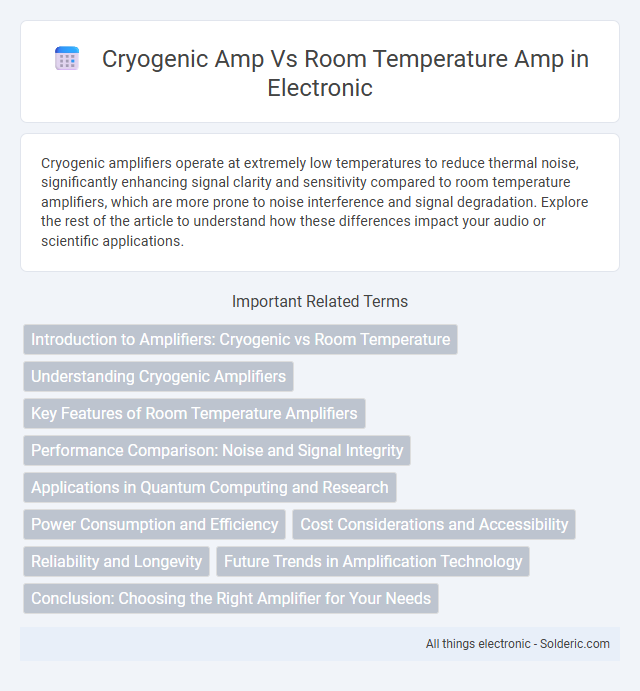Cryogenic amplifiers operate at extremely low temperatures to reduce thermal noise, significantly enhancing signal clarity and sensitivity compared to room temperature amplifiers, which are more prone to noise interference and signal degradation. Explore the rest of the article to understand how these differences impact your audio or scientific applications.
Comparison Table
| Feature | Cryogenic Amplifier | Room Temperature Amplifier |
|---|---|---|
| Operating Temperature | Below -150degC (typically 4K to 77K) | Room temperature (~20degC to 25degC) |
| Noise Level | Extremely low noise, ideal for sensitive measurements | Higher noise floor, less sensitive |
| Gain Stability | Highly stable under cryogenic conditions | Stable but affected by temperature variations |
| Power Consumption | Low power dissipation, but requires cooling systems | Higher power consumption, no cooling needed |
| Applications | Quantum computing, radio astronomy, superconducting detectors | General electronics, audio amplification, communication systems |
| Complexity & Cost | High complexity and cost due to cooling infrastructure | Lower complexity and cost |
| Signal Bandwidth | High bandwidth with low distortion | Moderate bandwidth, potentially higher distortion |
Introduction to Amplifiers: Cryogenic vs Room Temperature
Cryogenic amplifiers operate at extremely low temperatures, significantly reducing thermal noise and enhancing signal sensitivity compared to room temperature amplifiers. Room temperature amplifiers function at standard environmental conditions but exhibit higher noise levels and limited signal amplification efficiency. The choice between cryogenic and room temperature amplifiers depends on the application's sensitivity requirements and operating environment.
Understanding Cryogenic Amplifiers
Cryogenic amplifiers operate at extremely low temperatures, often near absolute zero, significantly reducing thermal noise and enhancing signal clarity compared to room temperature amplifiers. These devices are essential in applications requiring ultra-sensitive measurements, such as quantum computing and radio astronomy, where preserving signal integrity is critical. By using a cryogenic amplifier, you can achieve higher gain and better noise performance that room temperature amplifiers cannot match.
Key Features of Room Temperature Amplifiers
Room temperature amplifiers operate efficiently without the need for extreme cooling, offering convenience and cost-effectiveness for everyday applications. They deliver reliable performance across a broad range of temperatures, making them suitable for standard electronic systems requiring moderate noise levels and power consumption. Your choice of room temperature amplifiers ensures easy integration and maintenance without the complexities associated with cryogenic cooling systems.
Performance Comparison: Noise and Signal Integrity
Cryogenic amplifiers exhibit significantly lower noise figures compared to room temperature amplifiers, enhancing signal integrity by reducing thermal noise that typically limits sensitivity. The reduced electron scattering at cryogenic temperatures leads to improved gain stability and bandwidth, which is critical for high-precision applications such as quantum computing and radio astronomy. Room temperature amplifiers, while more practical, generally suffer from higher noise levels and signal distortion, making them less ideal where ultra-high fidelity and minimal signal degradation are required.
Applications in Quantum Computing and Research
Cryogenic amplifiers operate at extremely low temperatures, providing ultra-low noise performance essential for quantum computing qubit readout and precise signal amplification in quantum research experiments. Room temperature amplifiers, while more convenient, exhibit higher thermal noise, limiting their sensitivity and effectiveness in detecting faint quantum signals. The superior noise characteristics and signal fidelity of cryogenic amps make them indispensable in advanced quantum computing architectures and experimental quantum physics.
Power Consumption and Efficiency
Cryogenic amplifiers operate at extremely low temperatures, significantly reducing thermal noise and power consumption compared to room temperature amplifiers, leading to enhanced signal-to-noise ratios. Their efficiency is markedly higher due to superconducting components that minimize resistive losses, enabling improved performance in sensitive applications like quantum computing and radio astronomy. Conversely, room temperature amplifiers consume more power and exhibit lower efficiency due to higher thermal noise and resistive heating inherent in standard semiconductor materials.
Cost Considerations and Accessibility
Cryogenic amps typically involve higher upfront costs due to specialized cooling equipment and maintenance requirements, making them less accessible for casual users or small-scale labs. Room temperature amps offer a more cost-effective and readily available solution, suitable for broader applications without needing complex infrastructure. You can optimize your budget and accessibility by selecting room temperature amps unless ultra-low noise and sensitivity justify investing in cryogenic technology.
Reliability and Longevity
Cryogenic amplifiers offer enhanced reliability and longevity due to reduced thermal noise and minimized electron mobility degradation at low temperatures, leading to less wear on components over time. In contrast, room temperature amplifiers face higher thermal stress and increased risk of component failure, which can shorten their operational lifespan. The extreme cooling in cryogenic amps significantly extends device durability, benefiting applications requiring consistent high performance and minimal maintenance.
Future Trends in Amplification Technology
Cryogenic amplifiers offer reduced thermal noise and enhanced signal clarity compared to room temperature amplifiers, making them ideal for cutting-edge quantum computing and deep-space communication applications. Advancements in superconducting materials and cryogenic cooling systems are driving the development of more efficient, compact, and reliable amplification devices. Your future amplification solutions may increasingly rely on cryogenic technology to achieve unparalleled performance in sensitivity and bandwidth.
Conclusion: Choosing the Right Amplifier for Your Needs
Cryogenic amplifiers offer superior noise performance and higher sensitivity, making them ideal for quantum computing and sensitive scientific measurements. Room temperature amplifiers provide more practicality, lower cost, and easier integration in everyday electronic applications. Selecting the right amplifier depends on the specific requirements of noise tolerance, budget, and operational environment.
Cryogenic amp vs Room temperature amp Infographic

 solderic.com
solderic.com